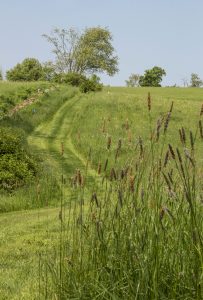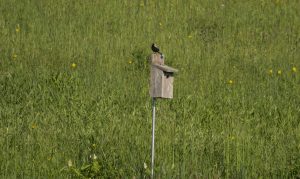Hatching a Plan: Bringing Back the Bobolinks
by Jessica Cusworth
As the Terracorps Land Stewardship Coordinator at the East Quabbin Land Trust, I feel extremely fortunate that I get to spend so much of my time outdoors monitoring and stewarding our conservation land. I’ve found that the most rewarding projects for me are those focused on wildlife conservation. This past March, I started my first wildlife habitat enhancement project at EQLT’s Wendemuth Meadow Preserve. This project focuses on enhancing grassland habitat for Bobolinks, which like the other grassland birds in our region, are facing sharp population declines. This is mostly a result of habitat loss, as these birds require large patches of grasslands for successful nesting.
EQLT has monitored the Bobolinks’ population declining at Wendemuth Meadow for the last few years. We’ve also noticed the grasses at Wendemuth Meadow aren’t growing as tall and dense as they once did, and that invasive knapweed is expanding its range on the property. Our theory is that the declining grassland conditions may be contributing to the decreasing Bobolink population at the property.
With the help of EQLT’s stewardship volunteers, I’ve put together a grassland restoration project for Bobolinks and other grassland birds on a two-acre section of Wendemuth Meadow. I’m hopeful that this is just a first step in a multi-phase project where we can replicate successful grassland improvements on the rest of the property in the future.
Our goal at Wendemuth Meadow is to increase the vigor of the grasses by enhancing soil quality, altering the species composition of the grasses, and treating invasive plants in the grasslands. We’ve started our experiment with grassland improvements on a two-acre section of the property, which has been divided into quarters to create four experimental plots. We’re looking to identify the most successful fertilizer treatment (conventional vs. regenerative) and grass mix combination from these plots based on which plot grows the most dense and tall grasses.
We’ll measure the new grasses just before the annual mowing in late July after the Bobolinks have fledged. The most effective fertilizer and grass seed mix will be based on the dry weight and height of the grasses in each quarter of the field. With more funding, I hope to replicate the most successful methods on the rest of the grasslands on the property in the future.
I spent the last week of March out on the 2-acre field with members of our stewardship team laying down fertilizer and overseeding the new grass mixes. Now, I’m eagerly waiting for these new grasses to grow so I can begin taking measurements and for the Bobolinks to return in (hopefully) larger numbers. It’s true what they say—if you love what you do, you’ll never work (or serve) another day in your life!
Jessica served as a Land Stewardship Coordinator at East Quabbin Land Trust for TerraCorps 2018-2019
